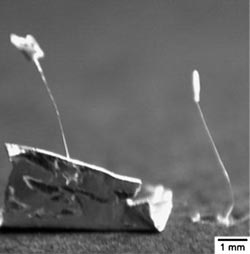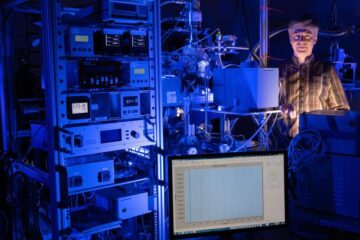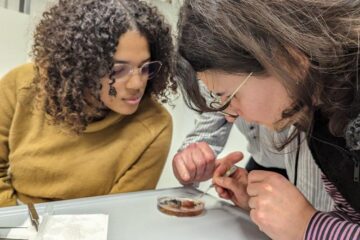Eggs on Stalks

<br>
Silk is a fascinating material, not just in fashion, but also in science and engineering, because the outstanding mechanical properties of these whisper-thin threads made by insects easily overshadow most man-made fibers.
German researchers have now taken inspiration from the lacewing, which lays its eggs on stalks made of silk with extremely high tensile strength. As they report in the journal Angewandte Chemie, they successfully produced synthetic egg stalks from biotechnologically generated proteins modeled on an egg-stalk protein.
Lacewings are light-green insects with transparent wings that are used by farmers to combat aphids. In order to protect their own offspring from predators, lacewings lay their eggs on very fine but extremely resilient silk stalks. To do this, the lacewing sticks a drop of silk dope from its abdomen to the underside of a leaf. It then presses an egg into the drop and pulls it downward. In this way, it pulls a thread that hardens within a few seconds in the air – the egg is now secured under the leaf. The threads are significantly finer than a human hair, but are so strong that they do not bend under the weight of the egg when the leaf is turned over.
The lacewing’s silk dope secretion contains several different proteins. One of the proteins contains a core domain with many repeated similar sequences. This area is flanked by small terminal domains that essentially control the properties of the silk proteins.
Thomas Scheibel and Felix Bauer at the University of Bayreuth wanted to produce an egg stalk with properties as similar as possible to the lacewing stalks. They thus developed a synthetic egg-stalk protein made of eight repeated building blocks consisting of 48 amino acids based on the repeating units of the natural silk protein. The end units were copied exactly from the original. The researchers synthesized a gene segment that codes for this artificial protein and introduced it into bacteria that then produce the protein.
Imitating silk stalk formation, the researchers dipped tweezers into a drop of protein solution, pulled out a filament, and attached the end of the stalk to a piece of aluminum foil. After drying, the stalks had similar tensile strength and elasticity to the natural version. At higher humidity, lacewing egg stalks are superior: they can be stretched out to up to six times their original length without tearing. The reason for this is the special accordion-like structure of other silk components. The researchers are confident that they will also be able to imitate this.
Possible applications for future synthetic silks range from the vehicle construction, for example in airbags, to medical applications, such as synthetic nerve conduits or drug delivery.
About the Author
Professor Thomas Scheibel is the Chair of Biomaterials at the University of Bayreuth (Germany). His research focuses on the biomimetic production of protein fibers as well as the production of protein-based materials for technical, pharmaceutical, and medical applications. He is Head of the Technical Committee “Bioinspired Materials” of the German Society for Materials Research (DGM). He won the Bionics Prize (2006), the “Innovation from Nature challenge” (2007) of the German Federal Ministry of Education and Research, and the Karl Heinz Beckurts Award (2008) for the biomimetic production of spider silks.
Author: Thomas Scheibel, Universität Bayreuth (Germany), http://www.fiberlab.de/
Title: Artificial Egg Stalks Made of a Recombinantly Produced Lacewing Silk Protein
Angewandte Chemie International Edition, Permalink to the article: http://dx.doi.org/10.1002/anie.201200591
Media Contact
All latest news from the category: Life Sciences and Chemistry
Articles and reports from the Life Sciences and chemistry area deal with applied and basic research into modern biology, chemistry and human medicine.
Valuable information can be found on a range of life sciences fields including bacteriology, biochemistry, bionics, bioinformatics, biophysics, biotechnology, genetics, geobotany, human biology, marine biology, microbiology, molecular biology, cellular biology, zoology, bioinorganic chemistry, microchemistry and environmental chemistry.
Newest articles

Peptides on Interstellar Ice
A research team led by Dr Serge Krasnokutski from the Astrophysics Laboratory at the Max Planck Institute for Astronomy at the University of Jena had already demonstrated that simple peptides…

A new look at the consequences of light pollution
GAME 2024 begins its experiments in eight countries. Can artificial light at night harm marine algae and impair their important functions for coastal ecosystems? This year’s project of the training…

Silicon Carbide Innovation Alliance to drive industrial-scale semiconductor work
Known for its ability to withstand extreme environments and high voltages, silicon carbide (SiC) is a semiconducting material made up of silicon and carbon atoms arranged into crystals that is…





















